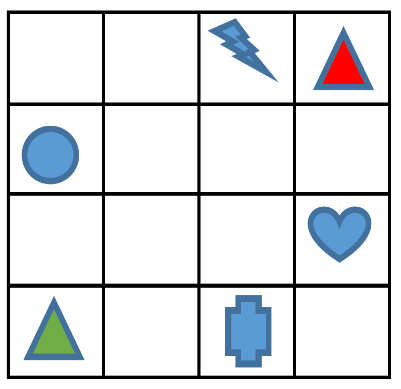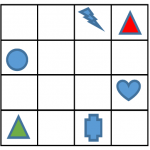Thanks to teachers from Karratha Public School.
Learning Objective:
Give clear directions, follow directions and use coordinates to locate places on a grid.
Intended Outcome:
Following directions accurately.
Materials:
- If playing option one, masking tape.
- If playing option one, an assortment of random objects.
- If playing option two, an A4 sized 4 x 4 grid.
- If playing option three, an A4 sized 4 x 4 grid for each student or student pair.
- If playing option four or five, an A4 sized 6 x 6 grid for each student.
- If playing option four or five, an A–F die.
- If playing option four or five, a six-sided die.
Instructions:
First, mark out a 4 x 4 grid on the classroom floor using the masking tape. Once this is done, there are five game options to play:
- Option 1: Place some obstacles on various squares on the grid. Students give directions to one player to get from one side of the grid to the other without hitting the obstacles.
- e.g. Starting at the green triangle, take one step forward, turn to the right and take one step, turn to the left and take one step, turn right and take two steps, turn left and take one step to finish on the red triangle.
- This can also be done using compass directions (north, south, east and west).
- Option 2: The teacher has a hidden copy of the grid that shows a path through the grid.
- The students must find their way through the grid by guessing where the correct path lies. When the student takes a step on the grid, the teacher must say “yes” if the student is on the correct path and “no” if they are not on the correct path.
- When the student takes a wrong step, their turn is over and the next student has their turn. Other students can watch to learn where the path lies, and give directions to the student whose turn it is.
- See how many tries it takes to get one student through the grid.
- Option 3: The teacher calls a series of directions that the students must follow to trace the path on their grid. See if they all end up at the same place!
- This could be played using directional navigation (left, right, forwards, backwards), compass bearings (north, south, east, west) or grid coordinates.
- Option 4: Use a 6×6 grid and label the x-axis with the letters A–F and the y-axis with the numbers 1–6.
- Students then colour in ten random squares on their grid.
- Using an A–F die and a six-sided number die, call out the coordinates as they appear on the dice when rolled. If a student has the called coordinate, they mark it off. The first student to have five coordinates marked off wins. Or, alternatively, the first student to have all ten of their coordinates marked off wins.
- Option 5: This game is played similarly to option four. However, as well as labelling the x-axis with letters A–F and the y-axis with numbers 1–6, the student also fills up the entire grid with numbers that belong to up to four fact families (e.g. 2,5,10…. 3,4,12…. 4,8,12…. 5,10,15….). These numbers can be written in the grid randomly.
- Again using an A–F die and a six-sided die, students mark off the coordinates called. The student who is first to tick off an entire fact family wins – if they can tell you the four facts for that family. You may like to limit the fact families to addition/subtraction or multiplication/division or leave it open, depending on the students.
- Hint: Strategy may come into play when choosing the numbers to go on the grid – what numbers belong to more than one fact family?
Variations:
For something a bit more challenging, try playing battleship!
- For an interactive one player versus a computer game go to: https://www.mathplayground.com/battleship.html (Math Playground, 2015)
- For an interactive player versus player game go to: https://battleship-game.org/en/ (Battleship-Game, 2016)
- You can always draw up your own paper version of the game too!
For something extra challenging, play on a four quadrant Cartesian plane.




